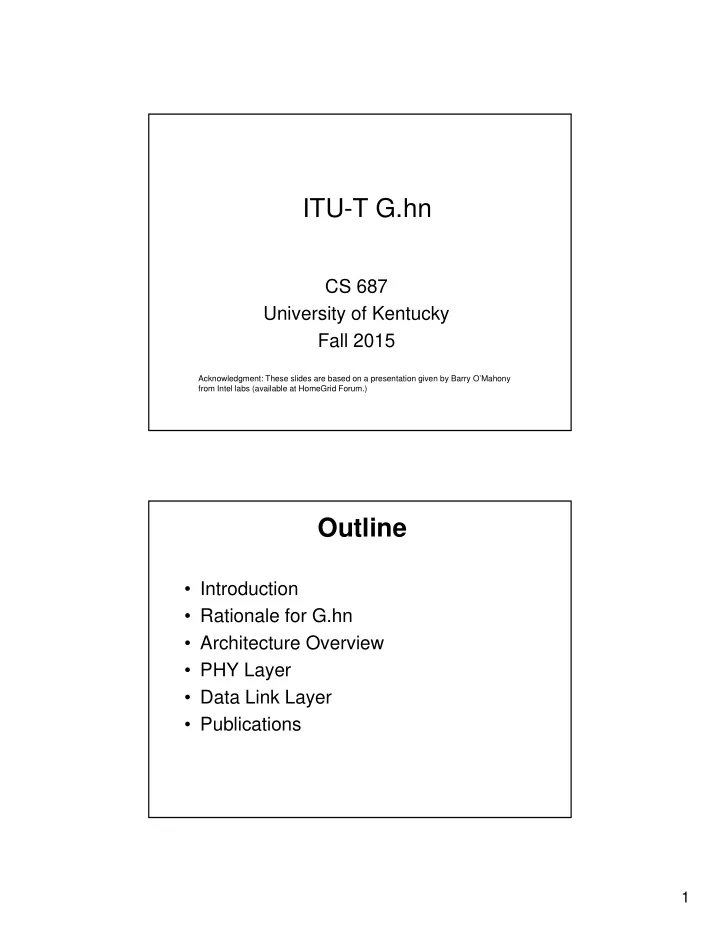

ITU-T G.hn CS 687 University of Kentucky Fall 2015 Acknowledgment: These slides are based on a presentation given by Barry O’Mahony from Intel labs (available at HomeGrid Forum.) Outline • Introduction • Rationale for G.hn • Architecture Overview • PHY Layer • Data Link Layer • Publications 1
Introduction • G.hn: An international standard for home networking on existing premises wiring – Power line – Coaxial cable – Telephone wiring • Developed by the International Telecommunication Union – Telecommunication Standardization Sector (ITU-T) • PHY/MAC standard with up to 1 Gbps performance • Promoted by the HomeGrid forum 2
• Founded in 2008 as companion group to support and promote ITU-T G.hn in the industry – Maket G.hn technology to the industry – Ensure compliance and interoperability • Worldwide industry representation – Service provider – Consumer electronics – Personal Computing – Silicon suppliers and IP licensing companies – Certification labs – Industry organizations • Board of directors – Best Buy, British Telecom, Lantiq, Intel, Sigma Designs, Telefonica, Texas Instruments, Marvell (pending) The Rationale for G.hn • Home Networking on existing wiring plagued by fragmentation, lack of interoperable standard – Market fragmented into small segments per distinct wire type – Multiple technologies per wire type, each supported by 1-2 vendors – Volumes miniscule in comparison to home networks based on international SDO standards (e.g., Wi-Fi, Ethernet) – Uncertainty inhibiting Service Providers adoption and consumer adoption • G.hn’s goal – establish single standard for all media and all regions – Parameterized single PHY and MAC that may be optimized for operation on each media, regional regulatory requirements – Best-in-class performance with contributions from all current coax/phoneline/powerline technology providers 3
4
G.hn PHY • Modulation: Windowed OFDM – Scalable power-of-2 FFT sizes • Several bandplans: baseband (up to 100 MHz), passband, and RF bandplans (350 MHz to 2450MHz) • Forward Error Control/Correction (FEC): Quasi-Cyclic Low Density Parity Check (QC-LDPC) code, similar to that used in WiMAX – Advantages over other advanced codes (e.g., Turbo codes) • LDPC better scalability at higher data rates • BLER operating point – Performance near Shannon theoretical limit – Two block sizes: 960 bits and 4320 bits (120 bytes and 540 bytes) – Five Code rates: ½, 2/3, 5/6, 16/18 and 20/21 PHY Framing • Preamble, PHY Frame Header, and Channel Estimation Symbol prepended to MPDU to make PHY Frame 5
Data Link Layer • Application Protocol Convergence (APC) – Interface to client application – Bit rate adaptation between client and HN • Logical Link Control (LLC) – Coordinates transmission as directed by the DM – Provides and enforces QoS – Provides Encryption – Provides retransmission when necessary – Control relaying • Medium Access Control (MAC) – Controls access to the medium – Contention based and contention-free access 6
Medium Access • DM assigns access according to MAC Cycles – Media Access Plan (MAP) message communicates access times to nodes – MAC cycles divided up to Transmission Opportunities (TXOP) • Various TXOP types – Contention Free TXOP (CFTXOP) • Associated with a single node and a flow/priority – Shared TXOP (STXOP) • Shared among nodes; divided into Time Slots (TS) • If a node assigned to the TS has a frame of the assigned priority ready, it transmits it; otherwise, it skips the TS and passes the transmission opportunity to the node/priority assigned for the next TS • No collision occurs if carrier sensing is sufficiently reliable. – Contention-Based TXOP (CBTXOP) is • a shared TXOP, in which assigned nodes may contend for transmission based on frame priority • Arranged by contention period. Security • Design Goal – State of the art security • E.g., comparable to other modern LAN networks • Threat model similar to wireless • AES128 Encryption • X.1035 Authentication and Key Exchange • Point-to-Point Encryption – Ensures that no device can decipher data transmitted between two other devices on the same network or no a neighboring network 7
Publications • ITU-T G.9960, Unified high-speed wire-line based home networking transceivers – Foundation • ITU-T G.9961, Data link layer (DLL) for unified high- speed wire-line based home networking transceivers • ITU-T G.9972 Co-existence mechanism for wireline home networking transceivers • ITU-T Technical Paper: Applications of ITU-T G.9960, ITU-T G.9961 transceivers for Smart Grid applications: Advanced metering infrastructure, energy management in the home and electric vehicles 8
Recommend
More recommend